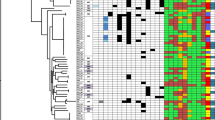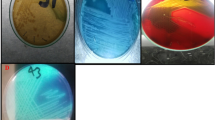Abstract
To analyse the antimicrobial phenotype, carbapenem mechanisms, integrons, virulence factors and molecular typing of 164 Pseudomonas aeruginosa isolates recovered from lower tract respiratory samples in a Spanish hospital (1 year) as well as the patients’ clinical data. Susceptibility testing to 12 antipseudomonal agents was determined by microdilution and metallo-beta-lactamase (MBL) phenotype by double disc method. The oprD gene was studied by PCR, sequencing and comparison with P. aeruginosa PAO1 sequence. Detection and characterisation of MBLs, class 1, 2 and 3 integrons, and virulence genes were studied by PCR and sequencing. The prevalence of carbapenem-resistant P. aeruginosa (CRPA) was 26.8%. MBL phenotype was detected in 52.3% CRPA, and all of them were disseminated throughout the intensive care unit. Most of the MBL-carrying patients presented respiratory disease, mechanical ventilation, tracheostomy, bacteraemia, ≥ 30 hospitalisation days and previous treatment with carbapenems and/or ≥ 3 different antimicrobial families. The blaVIM-2 gene was the unique MBL encoding gene and was detected inside class 1 integrons. The class 1 integrons detected in 39 strains (23.8%) were associated with aminoglycosides (aadB, aadA1, aadA6, aacA4, aac(3)-I) and carbapenems resistance genes (blaVIM-2). The aac(3)-I + aadA1 and blaVIM-2 arrangements were the most prevalent ones. Thirty-one different PFGE patterns and 4 STs (ST175, ST235, ST253, ST973) were detected among the 39 intI1-positive isolates, being ST235 the most frequent. CRPA showed a great variety of alterations in oprD gene. The exoU+/exoS− genotype was detected in 82.6% of blaVIM-2-producing strains (ST235) and the exoU−/exoS+ in the remaining 17.4% (ST973).



Similar content being viewed by others
References
Oliver A, Mulet X, López-Causapé C, Juan C (2015) The increasing threat of Pseudomonas aeruginosa high-risk clones. Drug Resist Updat 21-22:41–59
Mikucionyte G, Zamorano L, Vitkauskiene A, López-Causapé C, Juan C, Mulet X, Oliver A (2016) Nosocomial dissemination of VIM-2-producing ST235 Pseudomonas aeruginosa in Lithuania. Eur J Clin Microbiol Infect Dis 35:195–200
Salm F, Deja M, Gastmeier P, Kola A, Hansen S, Behnke M, Gruhl D, Leistner R (2016) Prolonged outbreak of clonal MDR Pseudomonas aeruginosa on an intensive care unit: contaminated sinks and contamination of ultra-filtrate bags as possible route of transmission? Antimicrob Resist Infect Control 5:53
Solé M, Fàbrega A, Cobos-Trigueros N, Zamorano L, Ferrer-Navarro M, Ballesté-Delpierre C, Reustle A, Castro P, Nicolás JM, Oliver A, Martínez JA, Vila J (2015) In vivo evolution of resistance of Pseudomonas aeruginosa strains isolated from patients admitted to an intensive care unit: mechanisms of resistance and antimicrobial exposure. J Antimicrob Chemother 70:3004–3013
Lister PD, Wolter DJ, Hanson ND (2009) Antibacterial-resistant Pseudomonas aeruginosa: clinical impact and complex regulation of chromosomally encoded resistance mechanisms. Clin Microbiol Rev 22:582–610
Rojo-Bezares B, Estepa V, Cebollada R, de Toro M, Somalo S, Seral C, Castillo FJ, Torres C, Sáenz Y (2014) Carbapenem-resistant Pseudomonas aeruginosa strains from a Spanish hospital: characterization of metallo-beta-lactamases, porin OprD and integrons. Int J Med Microbiol 304:405–414
Edelstein MV, Skleenova EN, Shevchenko OV, D'souza JW, Tapalski DV, Azizov IS, Sukhorukova MV, Pavlukov RA, Kozlov RS, Toleman MA, Walsh TR (2013) Spread of extensively resistant VIM-2-positive ST235 Pseudomonas aeruginosa in Belarus, Kazakhstan, and Russia: a longitudinal epidemiological and clinical study. Lancet Infect Dis 13:867–876
Schaber JA, Carty NL, McDonald NA, Graham ED, Cheluvappa R, Griswold JA, Hamood AN (2004) Analysis of quorum sensing-deficient clinical isolates of Pseudomonas aeruginosa. J Med Microbiol 53(Pt 9):841–853
Smith RS, Iglewski BH (2003) Pseudomonas aeruginosa quorum-sensing systems and virulence. Curr Opin Microbiol 6:56–60
Sawa T, Shimizu M, Moriyama K, Wiener-Kronish JP (2014) Association between Pseudomonas aeruginosa type III secretion, antibiotic resistance, and clinical outcome: a review. Crit Care 18:668
Clinical and Laboratory Standards Institute [CLSI] (2015) Performance Standards for Antimicrobial Susceptibility Testing: 25th Informational Supplement. CLSI Document M100-S25. CLSI, Wayne
Pasteran F, Mendez T, Guerriero L, Rapoport M, Corso A (2009) Sensitive screening tests for suspected class a carbapenemase production in species of Enterobacteriaceae. J Clin Microbiol 47:1631–1639
Gutiérrez O, Juan C, Cercenado E, Navarro F, Bouza E, Coll P, Pérez JL, Oliver A (2007) Molecular epidemiology and mechanisms of carbapenem resistance in Pseudomonas aeruginosa isolates from Spanish hospitals. Antimicrob Agents Chemother 51:4329–4335
Wolter DJ, Hanson ND, Lister PD (2004) Insertional inactivation of oprD in clinical isolates of Pseudomonas aeruginosa leading to carbapenem resistance. FEMS Microbiol Lett 236:137–143
Tenover FC, Arbeit RD, Goering RV, Mickelsen PA, Murray BE, Persing DH, Swaminathan B (1995) Interpreting chromosomal DNA restriction patterns produced by pulsed-field gel electrophoresis: criteria for bacterial strain typing. J Clin Microbiol 33:2233–2239
Lavenir R, Sanroma M, Gibert S, Crouzet O, Laurent F, Kravtsoff J, Mazoyer MA, Cournoyer B (2008) Spatio-temporal analysis of infra-specific genetic variations among a Pseudomonas aeruginosa water network hospital population: invasion and selection of clonal complexes. J Appl Microbiol 105:1491–1501
Peña C, Suarez C, Gozalo M, Murillas J, Almirante B, Pomar V, Aguilar M, Granados A, Calbo E, Rodríguez-Baño J, Rodríguez F, Tubau F, Martínez-Martínez L, Oliver A, Spanish Network for Research in Infectious Diseases REIPI (2012) Prospective multicenter study of the impact of carbapenem resistance on mortality in Pseudomonas aeruginosa bloodstream infections. Antimicrob Agents Chemother 56:1265–1272
Estepa V, Rojo-Bezares B, Azcona-Gutiérrez JM, Olarte I, Torres C, Sáenz Y (2017) Characterisation of carbapenem-resistance mechanisms in clinical Pseudomonas aeruginosa isolates recovered in a Spanish hospital. Enferm Infecc Microbiol Clin 35:141–147
Mulet X, Cabot G, Ocampo-Sosa AA, Domínguez MA, Zamorano L, Juan C, Tubau F, Rodríguez C, Moyà B, Peña C, Martínez-Martínez L, Oliver A, Spanish Network for Research in Infectious Diseases (REIPI) (2013) Biological markers of Pseudomonas aeruginosa epidemic high-risk clones. Antimicrob Agents Chemother 57:5527–5535
Peña C, Cabot G, Gómez-Zorrilla S, Zamorano L, Ocampo-Sosa A, Murillas J, Almirante B, Pomar V, Aguilar M, Granados A, Calbo E, Rodríguez-Baño J, Rodríguez-López F, Tubau F, Martínez-Martínez L, Oliver A, Spanish Network for Research in Infectious Diseases (REIPI) (2015) Influence of virulence genotype and resistance profile in the mortality of Pseudomonas aeruginosa bloodstream infections. Clin Infect Dis 60:539–548
Hong JS, Kim JO, Lee H, Bae IK, Jeong SH, Lee K (2015) Characteristics of Metallo-β-lactamase-producing Pseudomonas aeruginosa in Korea. Infect Chemother 47:33–40
Denamur E, Picard B, Decoux G, Denis JB, Elion J (1993) The absence of correlation between allozyme and rrn RFLP analysis indicates a high gene flow rate within human clinical Pseudomonas aeruginosa isolates. FEMS Microbiol Lett 110:275–280
Picard B, Denamur E, Barakat A, Elion J, Goullet P (1994) Genetic heterogeneity of Pseudomonas aeruginosa clinical isolates revealed by esterase electrophoretic polymorphism and restriction fragment length polymorphism of the ribosomal RNA gene region. J Med Microbiol 40:313–322
Kiewitz C, Tümmler B (2000) Sequence diversity of Pseudomonas aeruginosa: impact on population structure and genome evolution. J Bacteriol 182:3125–3135
Pirnay JP, Bilocq F, Pot B, Cornelis P, Zizi M, Van Eldere J, Deschaght P, Vaneechoutte M, Jennes S, Pitt T, De Vos D (2009) Pseudomonas aeruginosa population structure revisited. PLoS One 4:e7740
Maatallah M, Cheriaa J, Backhrouf A, Iversen A, Grundmann H, Do T, Lanotte P, Mastouri M, Elghmati MS, Rojo F, Mejdi S, Giske CG (2011) Population structure of Pseudomonas aeruginosa from five Mediterranean countries: evidence for frequent recombination and epidemic occurrence of CC235. PLoS One 6:e25617
Curran B, Jonas D, Grundmann H, Pitt T, Dowson CG (2004) Development of a multilocus sequence typing scheme for the opportunistic pathogen Pseudomonas aeruginosa. J Clin Microbiol 42:5644–5649
Wołkowicz T, Patzer JA, Kamińska W, Gierczyński R, Dzierżanowska D (2016) Distribution of carbapenem resistance mechanisms in Pseudomonas aeruginosa isolates among hospitalised children in Poland: characterisation of two novel insertion sequences disrupting the oprD gene. J Glob Antimicrob Resist 7:119–125
Cabot G, Ocampo-Sosa AA, Domínguez MA, Gago JF, Juan C, Tubau F, Rodríguez C, Moyà B, Peña C, Martínez-Martínez L, Oliver A, Spanish Network for Research in Infectious Diseases (REIPI) (2012) Genetic markers of widespread extensively drug-resistant Pseudomonas aeruginosa high-risk clones. Antimicrob Agents Chemother 56:6349–6357
Rodríguez-Martínez JM, Poirel L, Nordmann P (2009) Molecular epidemiology and mechanisms of carbapenem resistance in Pseudomonas aeruginosa. Antimicrob Agents Chemother 53:4783–4788
Ruiz-Martínez L, López-Jiménez L, d'Ostuni V, Fusté E, Vinuesa T, Viñas M (2011) A mechanism of carbapenem resistance due to a new insertion element (ISPa133) in Pseudomonas aeruginosa. Int Microbiol 14:51–58
Estepa V, Rojo-Bezares B, Torres C, Sáenz Y (2015) Genetic lineages and antimicrobial resistance in Pseudomonas spp. isolates recovered from food samples. Foodborne Pathog Dis 12:486–491
Ocampo-Sosa AA, Cabot G, Rodríguez C, Roman E, Tubau F, Macia MD, Moya B, Zamorano L, Suárez C, Peña C, Domínguez MA, Moncalián G, Oliver A, Martínez-Martínez L, Spanish Network for Research in Infectious Diseases (REIPI) (2012) Alterations of OprD in carbapenem-intermediate and -susceptible strains of Pseudomonas aeruginosa isolated from patients with bacteremia in a Spanish multicenter study. Antimicrob Agents Chemother 56:1703–1713
Epp SF, Köhler T, Plésiat P, Michéa-Hamzehpour M, Frey J, Pechère JC (2001) C-terminal region of Pseudomonas aeruginosa outer membrane porin OprD modulates susceptibility to meropenem. Antimicrob Agents Chemother 45:1780–1787
Patzer JA, Walsh TR, Weeks J, Dzierzanowska D, Toleman MA (2009) Emergence and persistence of integron structures harbouring VIM genes in the Children's memorial health institute, Warsaw, Poland, 1998-2006. J Antimicrob Chemother 63:269–273
Corvec S, Poirel L, Espaze E, Giraudeau C, Drugeon H, Nordmann P (2008) Long-term evolution of a nosocomial outbreak of Pseudomonas aeruginosa producing VIM-2 metallo-enzyme. J Hosp Infect 68:73–82
Nemec A, Krizova L, Maixnerova M, Musilek M (2010) Multidrug-resistant epidemic clones among bloodstream isolates of Pseudomonas aeruginosa in the Czech Republic. Res Microbiol 161:234–242
Rojo-Bezares B, Estepa V, de Toro M, Undabeitia E, Olarte I, Torres C, Sáenz Y (2011) A novel class 1 integron array carrying bla VIM-2 genes and a new insertion sequence in a Pseudomonas aeruginosa strain isolated from a Spanish hospital. J Med Microbiol 60(Pt 7):1053–1054
Gómez-Zorrilla S, Juan C, Cabot G, Camoez M, Tubau F, Oliver A, Domínguez MA, Ariza J, Peña C (2016) Impact of multidrug resistance on the pathogenicity of Pseudomonas aeruginosa: in vitro and in vivo studies. Int J Antimicrob Agents 47:368–374
Treepong P, Kos VN, Guyeux C, Blanc DS, Bertrand X, Valot B, Hocquet D (2018) Global emergence of the widespread Pseudomonas aeruginosa ST235 clone. Clin Microbiol Infect 24(3):258–266
Acknowledgments
This publication made use of the Pseudomonas aeruginosa MLST website (https://pubmlst.org/paeruginosa/) developed by Keith Jolley and sited at the University of Oxford (Jolley and Maiden 2010, BMC Bioinformatics, 11:595). The development of this site has been funded by the Wellcome Trust.
Funding
This work was partially supported by the Departamento de Ciencia, Tecnología and Universidad from the Gobierno de Aragón, Spain (Project DGA-European Social Fund (FSE)/Grupos consolidados, B24-211130. “Investing in your future”) and by the Instituto de Salud Carlos III of Spain [projects FIS “PI12/01276”, “PI16/01381”] (Co-funded by European Regional Development Fund (FEDER) “A way to make Europe”). Alba Bellés received a SEIMC2015 mobility internship to support her work in the laboratory of Microbiología Molecular (CIBIR).
Author information
Authors and Affiliations
Corresponding author
Ethics declarations
Conflict of interest
The authors declare that they have no conflict of interest.
Ethical approval
This article does not contain any studies with human participants or animals performed by any of the authors.
Informed consent
Informed consent was obtained from all the participants’ sampling. Given that no subject-identifiable data were generated and the surveillance activities implied no risk or burden for any individuals, the committee/hospital/authors judged that no specific ethical permission was required for individual consent.
Rights and permissions
About this article
Cite this article
Bellés, A., Bueno, J., Rojo-Bezares, B. et al. Characterisation of VIM-2-producing Pseudomonas aeruginosa isolates from lower tract respiratory infections in a Spanish hospital. Eur J Clin Microbiol Infect Dis 37, 1847–1856 (2018). https://doi.org/10.1007/s10096-018-3318-3
Received:
Accepted:
Published:
Issue Date:
DOI: https://doi.org/10.1007/s10096-018-3318-3




